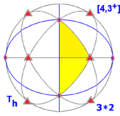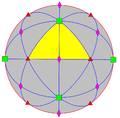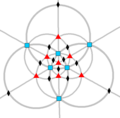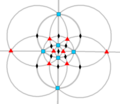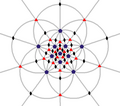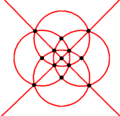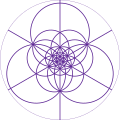Geometric polyhedral group
Selected point groups in three dimensions

Involutional symmetry
Cs, (*)
[ ] = 
|

Cyclic symmetry
Cnv, (*nn)
[n] =   
|

Dihedral symmetry
Dnh, (*n22)
[n,2] =     
|
| Polyhedral group, [n,3], (*n32)
|

Tetrahedral symmetry
Td, (*332)
[3,3] =     
|

Octahedral symmetry
Oh, (*432)
[4,3] =     
|

Icosahedral symmetry
Ih, (*532)
[5,3] =     
|
In geometry, the polyhedral group is any of the symmetry groups of the Platonic solids.
Groups
There are three polyhedral groups:
- The tetrahedral group of order 12, rotational symmetry group of the regular tetrahedron. It is isomorphic to A4.
- The conjugacy classes of T are:
- identity
- 4 × rotation by 120°, order 3, cw
- 4 × rotation by 120°, order 3, ccw
- 3 × rotation by 180°, order 2
- The octahedral group of order 24, rotational symmetry group of the cube and the regular octahedron. It is isomorphic to S4.
- The conjugacy classes of O are:
- identity
- 6 × rotation by ±90° around vertices, order 4
- 8 × rotation by ±120° around triangle centers, order 3
- 3 × rotation by 180° around vertices, order 2
- 6 × rotation by 180° around midpoints of edges, order 2
- The icosahedral group of order 60, rotational symmetry group of the regular dodecahedron and the regular icosahedron. It is isomorphic to A5.
- The conjugacy classes of I are:
- identity
- 12 × rotation by ±72°, order 5
- 12 × rotation by ±144°, order 5
- 20 × rotation by ±120°, order 3
- 15 × rotation by 180°, order 2
These symmetries double to 24, 48, 120 respectively for the full reflectional groups. The reflection symmetries have 6, 9, and 15 mirrors respectively. The octahedral symmetry, [4,3] can be seen as the union of 6 tetrahedral symmetry [3,3] mirrors, and 3 mirrors of dihedral symmetry Dih2, [2,2]. Pyritohedral symmetry is another doubling of tetrahedral symmetry.
The conjugacy classes of full tetrahedral symmetry, Td ≅ S4, are:
- identity
- 8 × rotation by 120°
- 3 × rotation by 180°
- 6 × reflection in a plane through two rotation axes
- 6 × rotoreflection by 90°
The conjugacy classes of pyritohedral symmetry, Th, include those of T, with the two classes of 4 combined, and each with inversion:
- identity
- 8 × rotation by 120°
- 3 × rotation by 180°
- inversion
- 8 × rotoreflection by 60°
- 3 × reflection in a plane
The conjugacy classes of the full octahedral group, Oh ≅ S4 × C2, are:
- inversion
- 6 × rotoreflection by 90°
- 8 × rotoreflection by 60°
- 3 × reflection in a plane perpendicular to a 4-fold axis
- 6 × reflection in a plane perpendicular to a 2-fold axis
The conjugacy classes of full icosahedral symmetry, Ih ≅ A5 × C2, include also each with inversion:
- inversion
- 12 × rotoreflection by 108°, order 10
- 12 × rotoreflection by 36°, order 10
- 20 × rotoreflection by 60°, order 6
- 15 × reflection, order 2










